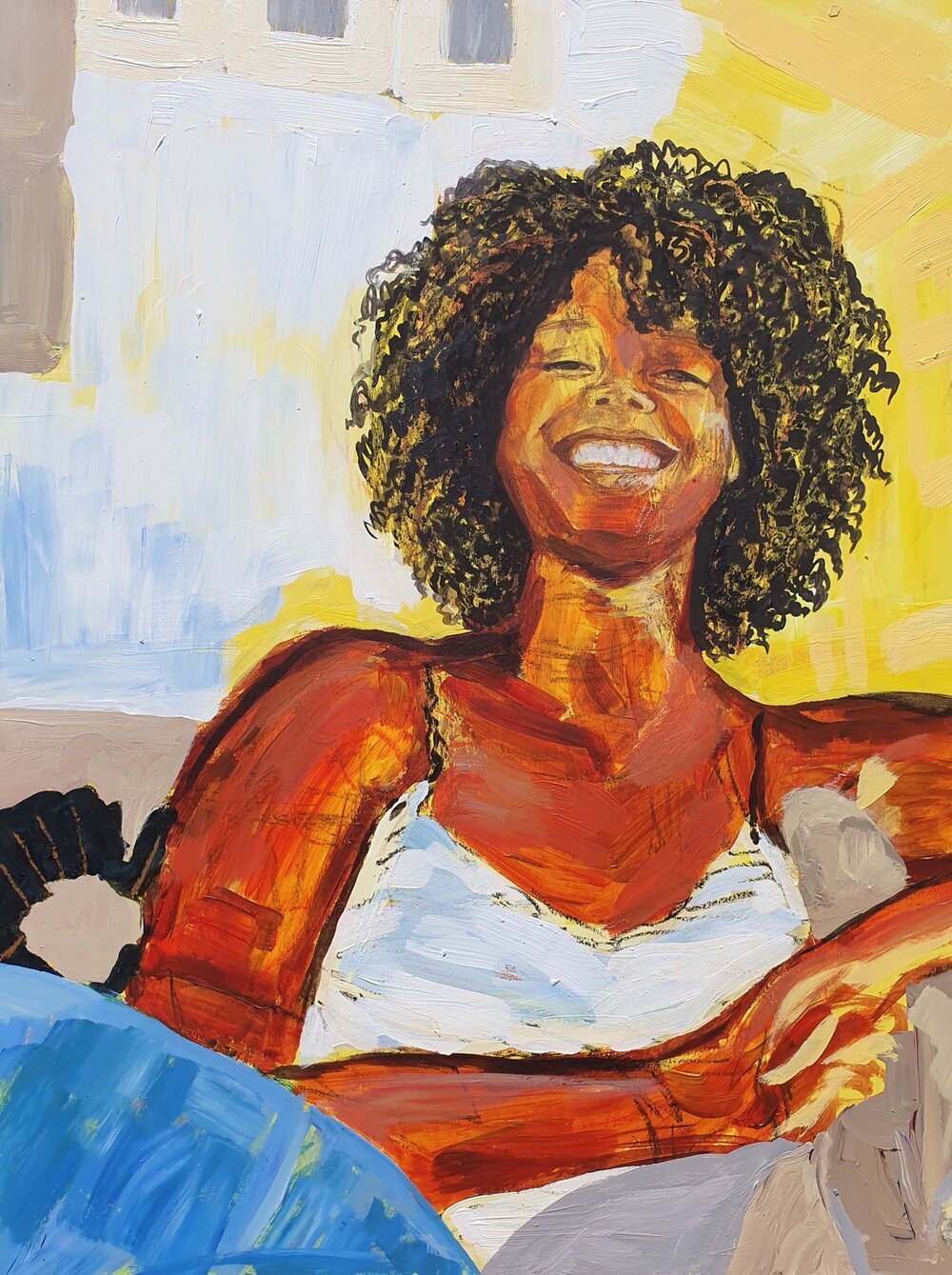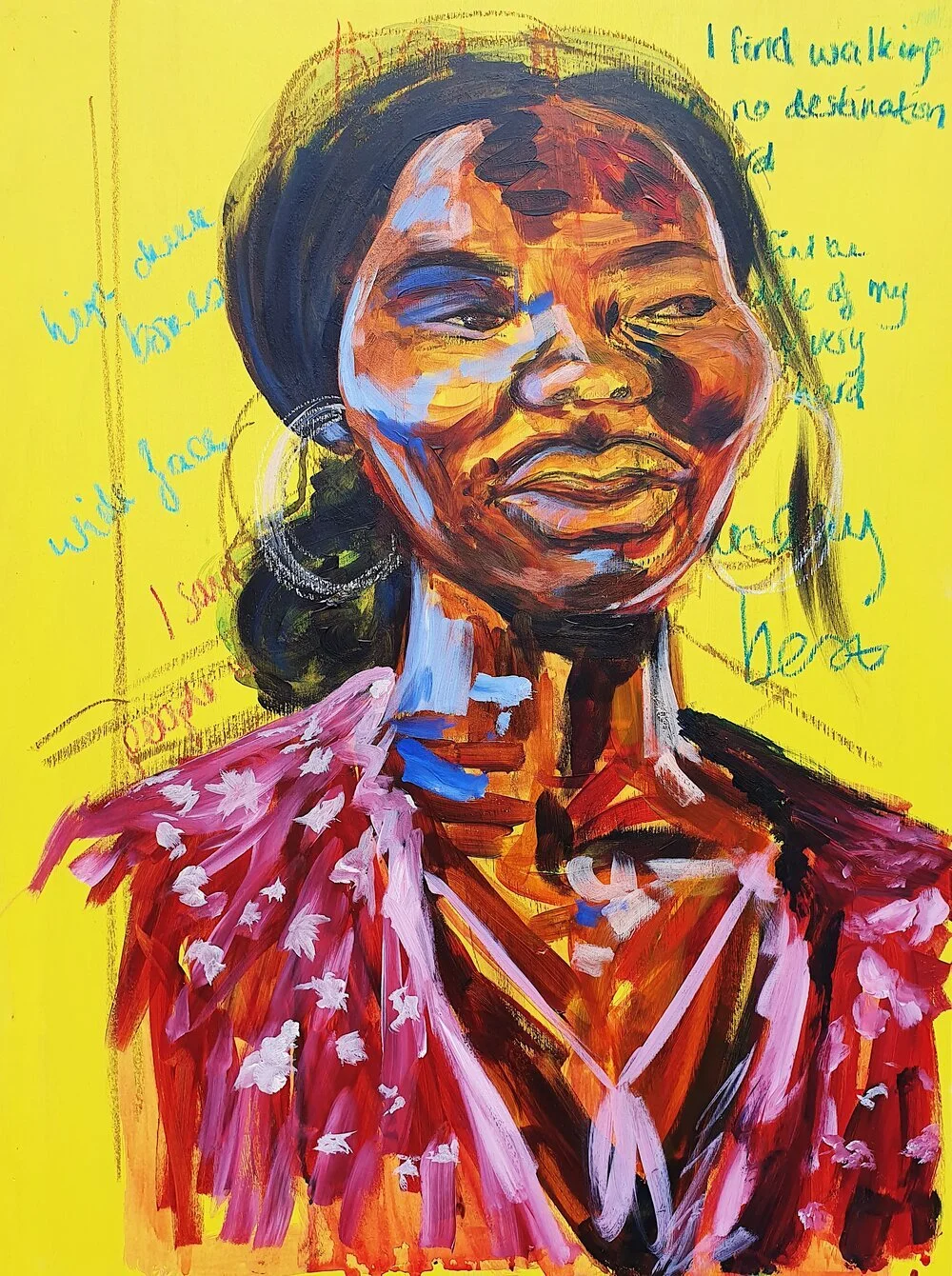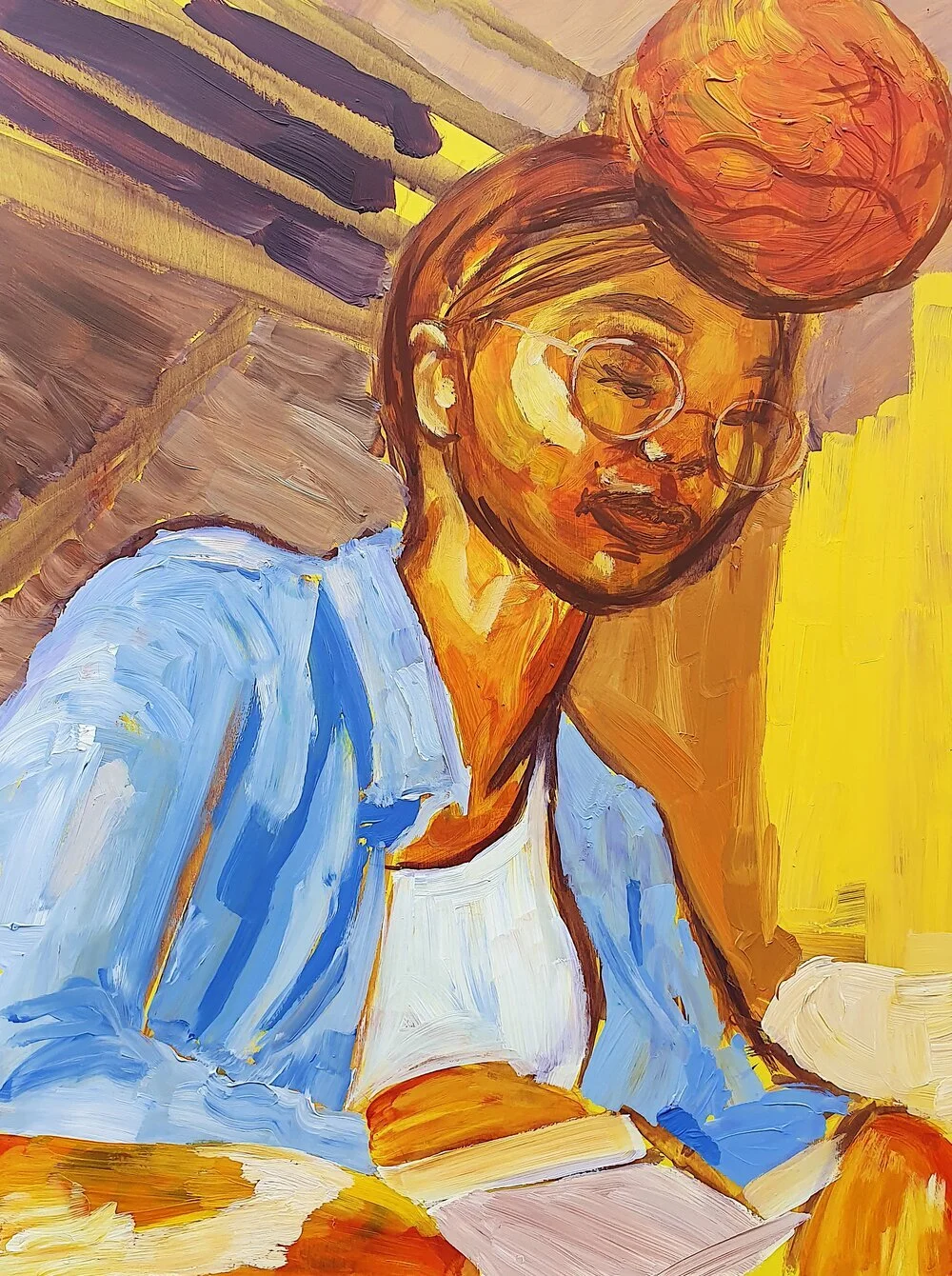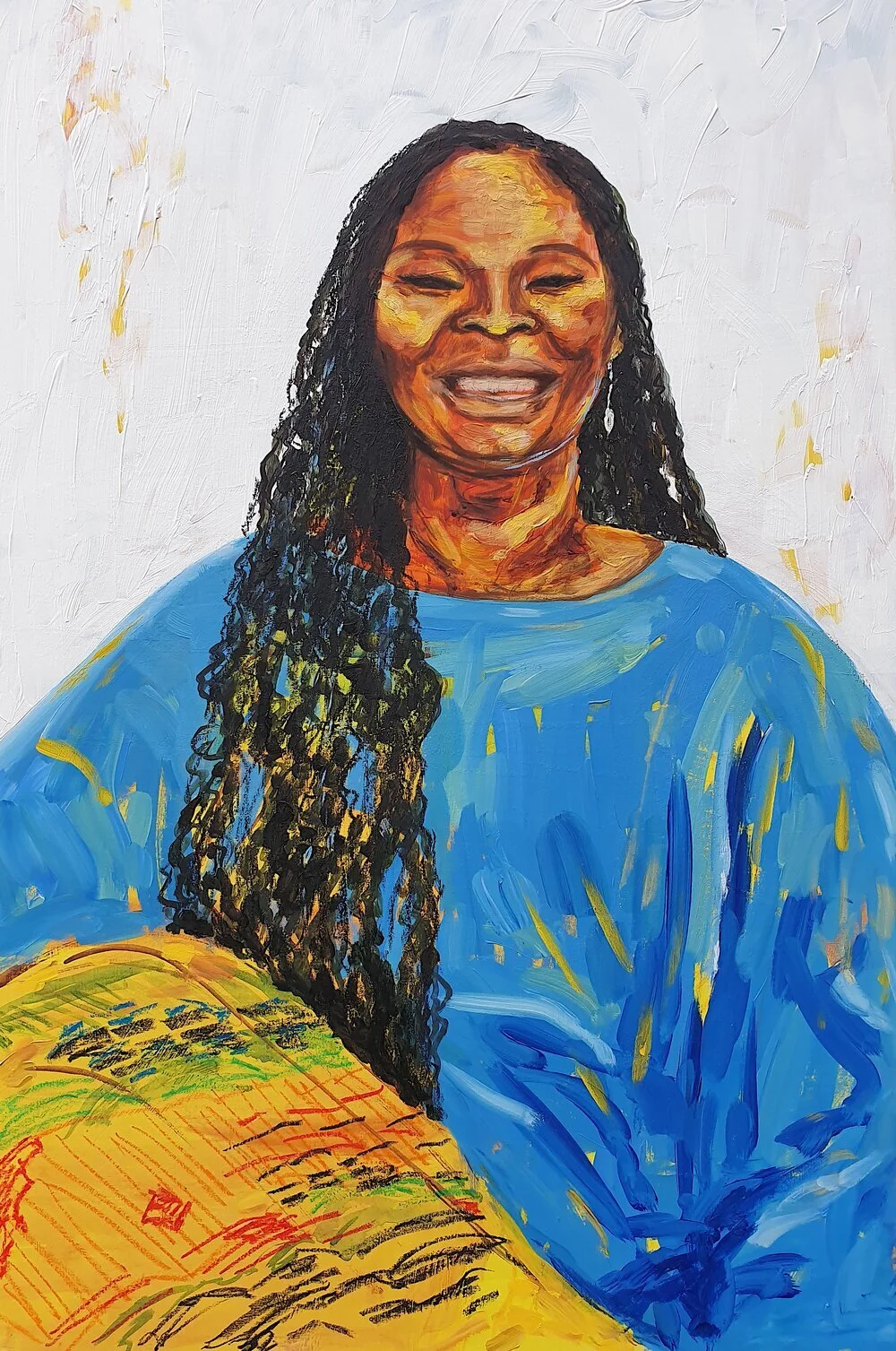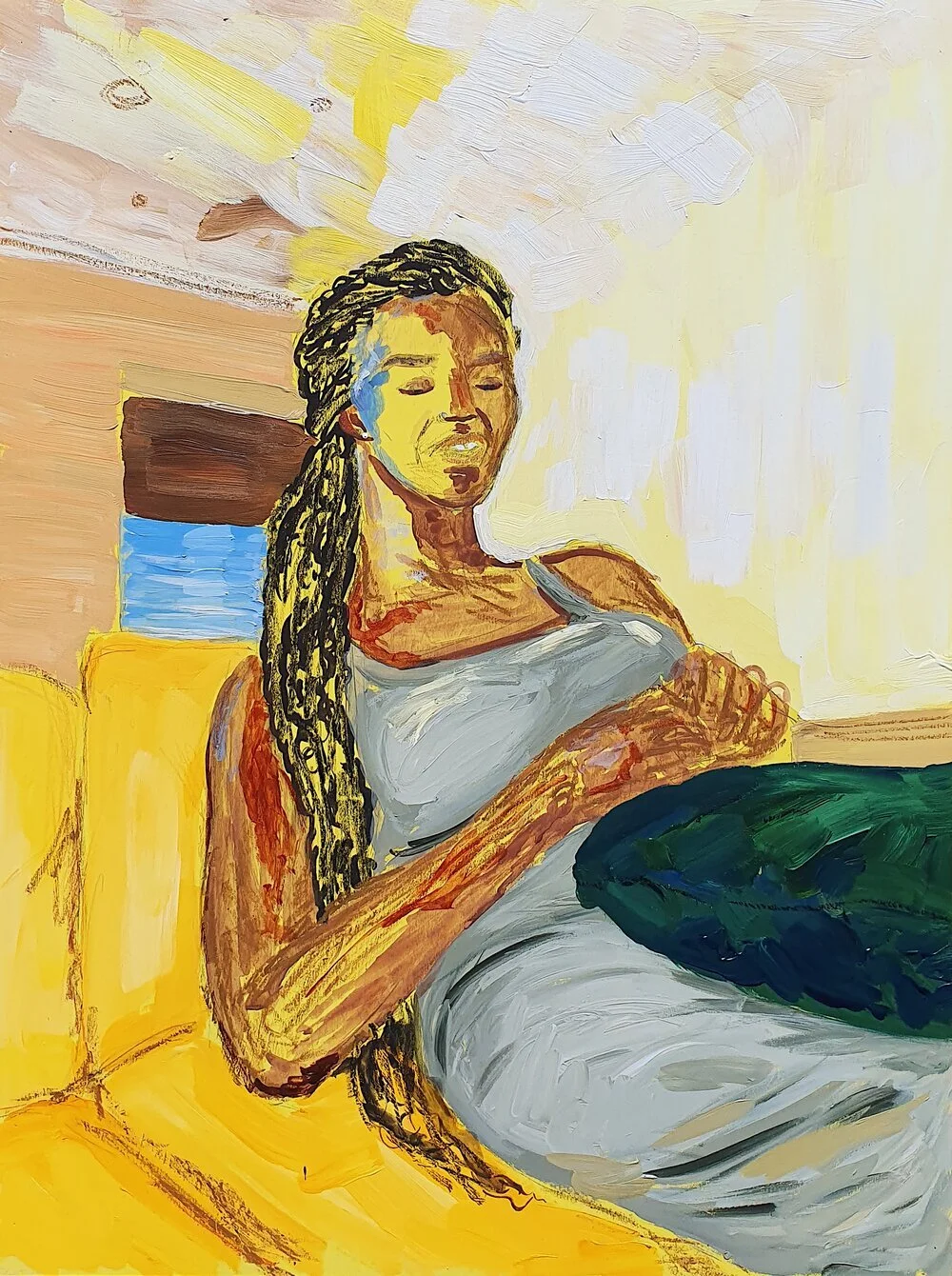Let Your Light Shine
Zanda by Gayle Ebose
A brand new interview with British artist Gayle Ebose 🌼 Her portraits explore femininity, motherhood and the ageing body, here’s what you missed 💛
Addy: Gayle, thanks so much for joining me today! Have you always known that you wanted to be an artist?
Gayle: That's a good question. I don't know if it's necessarily that I've always known that I wanted to be an artist, but it's more like, I've always had it in me. I think from a young age, I was always drawing, colouring and painting. It’s always been a part of who I am. My dad always says things like, "Oh, it's in your blood," that kind of thing.
Addy: Were you interested in art during school?
Gayle: I was always artistic, I did fine art for GCSE and for A-Level. I didn't do it at university, I studied broadcast journalism, but I was painting every now and then. I'd do commissions and stuff like that. Then I had a moment of just trying to figure out what I wanted to do, and that's when I started taking up art again. It's always been there, like peaks and troughs.
Addy: I love that. Your portraits explore femininity and the ageing body. Why did you decide to explore these themes?
Gayle: I'll say it from the standpoint of me being a storyteller: I'm speaking from my perspective, in the sense that this is my lens. I look at the world through my femininity, through my physical experience, but also knowing that I'm a spiritual being. This is my vessel, through which I navigate life.
I’ve always approached storytelling in that way. My MA course also helped with this, I learned how to look outside of myself and see how these experiences happen to other people as well.
I'm able to see how people experience life through their femininity and through the fragilities of life, through their personal experiences. That's what helps me to paint them, and I'm able to have that relationship with them because I know that it’s something that I've also experienced, so I’m able to understand them. Do you get what I mean?
Addy: Yes, totally.
Gayle: I think ultimately, that's just the way I see life, so I paint from that standpoint.
Bola by Gayle Ebose
Addy: That's really interesting. Your subjects influence your technique in terms of brush strokes, describe your creative process.
Gayle: From conception, it's a case of praying. I'm like, "God, I want to talk about how you sustain your people. Help me, show me the person that I should be painting. Who should I be listening to?" So I tend to just look around for people, mainly in my church. Usually I'll just be speaking to my friends, then I’ll ask them, "Can I paint you? Let's have a conversation over video call," similar to what we're doing now.
Whilst we're talking and whilst they're speaking about their experiences, I paint them. It's like my brush strokes are guided by the conversation that's taking place. I'm not necessarily painting for the sake of likeness, it's more the experience of the whole thing. I find that it just flows through conversation.
Addy: Do you always paint as you're speaking to somebody or do you ever have a conversation, and then go away and paint?
Gayle: No, it's all at the same time. I’ll have my easel up whilst I’m talking to them. Often I'll just be looking at them as I paint, it'll be a back and forth conversation. There were times, especially during my MA, where I would have specific questions, but normally, because these are people that I know, it's just a free flowing conversation. It doesn't feel awkward or uncomfortable, it's just natural.
Addy: Would you ever paint somebody that you don't know very well? Do you feel like you could still capture the essence of that person?
Gayle: I think right now, where I am in my practice, I am looking at people who are of the Christian faith. Because I'm specifically looking at those people, I tend to just paint people that I know. There might be some images that I see, where I'm like, “There's a certain light to that person or uniqueness about them,” that I might want to paint. Or maybe I might know of them, then I’m likely to be more drawn [to that person] and to consider painting them.
More often than not, I think I do see a slight difference. I think the experience of painting somebody I know is different because the conversation is easier. Whereas if I'm painting someone I don't know, it's more like a photograph. I'm not having the same type of conversation. It's more like I'm just painting them because I'm painting them. Does that make sense?
Addy: Yes, completely. Your relationship with the subject is really fascinating and also makes your work more personal. Do you tend to use oil on canvas or do you like to experiment with different materials?
Gayle: It has definitely been experimental, but I always gravitate towards acrylic paint. I just feel the most comfortable with acrylic. I think oils give me a bit of a headache. (laughs) Acrylic paint is just my go-to, but then I’ve also incorporated things like watercolours and oil pastels. Sometimes I'll use the oil pastels and the watercolour to actually map out the person first, then I'll go into it with acrylic. That tends to be how I paint actually, and I use coloured pencils.
Addy: That's really cool. How did lockdown affect your creativity?
Gayle: That's a good question. Half of my MA was completed during lockdown. I started in October of 2019, lockdown happened in March, and then I finished the course in October 2020. It was like six months in, six months out. I think 2020 was quite a sobering year, a time for people to reflect and think. I was just so grateful to be grounded and rooted in my faith. I don't know what tomorrow holds, but I know that there's light that's in Christ. I think that helped me. That was like an anchoring for me, in the midst of the turbulence that was 2020.
Stephany by Gayle Ebose
That also helped me to push through the course, because it was very isolating at times. A lot of people took the art course because they wanted to be in art school and to interact with people and to have the whole art school kind of feel. Whereas for me, that was cool, but I knew that I wanted a year to just pour into my creativity. That was literally the aim of doing the MA. I felt like I was able to still experience that, even in my room. We'd have the Zoom calls, and stuff like that, but I was still able to make work by myself. That's something that I'd always been doing in my practice anyway. Art school just brought the community into it, in a sense, like other artists discussing their work. That was something I'd never really experienced. I definitely think that the MA helped me to develop my practice, it taught me to allow my subjects to come alive a bit more, rather than before where I would paint from photographs, voice notes and stuff like that. The course and also being at home, helped me to see that there are other methodologies and other ways of painting a person, beyond the standard practice.
Addy: It’s amazing that despite everything going on around you, you were still able to develop your practice remotely. Okay, let’s talk a bit about London Grads Now!
Gayle: London Grads Now was a real blessing and a humbling time for me, to have my work exhibited at the Saatchi Gallery. It was a blessing, because it brought exposure. I've made lots of connections since, and sold work. It was a blessing. I really saw the fruit of it. I think ultimately, in the midst of everything, I was able to find joy.
Addy: Yay, I’m glad that you had such a wonderful experience! Your art is very personal to you. Who and what are your greatest influences? That can be music, film, family, anything.
Gayle: I think definitely my relationship with the Lord, because I consider myself a sojourner, someone who's passing through this life. That's definitely my primary influence, along with my community, the people around me, their lives inspire me. The way that they go through life-changing experiences and yet are still able to stand anchored. Human beings are really resilient, so I definitely find that inspirational.
In terms of other artists, I would say, Lynette Yiadom-Boakye, Toyin Ojih Odutola, Jordan Casteel, that's my lady. Alice Neel as well. That's my lady too. I see some of the parallels. It's like citizen journalism, that's what it feels like. You invite people over to your house and you chat about life. It's like therapy. The artists that I mentioned are definitely inspirational in terms of their practice, the way that they navigate through life.
Also, I think at the start of the MA, I was listening to a lot of Kanye, Jesus is King. That was a good album.
Addy: Omg, are you (still) a Kanye fan?
Gayle: I know, but that album was like, a cool album. I liked it.
Addy: Do you like to play music whilst you paint?
Gayle: I suppose the conversations are like the music? They’re the bedrock or the continuous sound that I'm listening to. I think I used to listen music, podcasts, just anything. I'd listen to stuff and just be dancing around and painting.
Addy: I love that.
Lola by Gayle Ebose
Gayle: I also like to go for walks, I try to go quite consistently. I love writing. I feel like writing is a heavy part of my process actually. That’s the initial stage of my process. A lot of journaling about my own experiences, my own thoughts, a lot of voice notes to myself as well. I definitely think being outside gives me a greater perspective. It allows me to come out of myself a bit more.
Addy: How has your practice evolved over time?
Gayle: I think the background of the subject is more important now, that has become the foundation of making a portrait, rather than just the visual elements. I used to see a photo and like the way that the person was sitting, or their posture. Then I would take the photo and paint it. It's less about that now. Even though I like that, I now think more about their voice, their face, the storytelling. What are they saying? What are their experiences? I think about how they live their life and their individuality as well. That's so key, because I think portraits of women in the past, especially black women, didn’t incorporate this. Some of those portraits don't even have names. I purposefully name all of my paintings after the sitters. I incorporate their names into the portraits as a way to give them an identity. They are their own person.
Addy: Would you say that the titles of your works are very important?
Gayle: Definitely, because they're the starting point. They allow your mind to wander, to think about who the person is. Sometimes I'll come up with the title whilst I'm painting them. Or sometimes I might ask them, “What do you think about this title?” whilst we're actually having the conversation. It also depends on how they are, emotionally, during the call. It's very sensitive, actually. (laughs)
I think it's important to have the person’s name in the title because it’s like a testimonial, preserving a part of them. Otherwise, you just wouldn't know who they are. Whereas now, it preserves at least their name. You’re putting a name to a face.
Addy: That's really lovely. I'm sure each person likes the fact that their name is incorporated into it. It's the beginning of the story, it's who they are, essentially.
Gayle: Yes, or even a part of their story, like a moment.
Addy: Do you have a favourite piece of work that you've created?
Gayle: I do. I feel like it's a taboo thing to say that I have a favourite. I do have a favourite and it's not for sale. I say that on purpose because I don't want anyone to try and buy it, because it's mine. (laughs) Do you want to know which one it is?
Addy: Yes!
Gayle: It's called Mansah, Joy Always Comes in the Morning.
Addy: I really like that one.
Mansah (Joy Always Comes In the Morning) by Gayle Ebose
Gayle: What do you like about it?
Addy: I think just the joy, she’s very happy and I feel like you captured a candid moment. Like maybe she was talking about something that she’s passionate about. I think often when people sit for paintings, they feel very aware of what they're doing, but in this moment it feels like she’s quite relaxed or maybe forgot that you were painting her.
Gayle: Yes, that’s one of the key things for me. I'm painting the person in their space. They’re in their room and I want them to feel comfortable. They don't need to sit still, I don't tell them to sit still because, at the end of the day, we're having a conversation, it's free. It's cool that you recognised that, that's really nice.
Addy: Am I allowed to know who this is? Is this a friend of yours?
Gayle: Yes, a lady from my church, her name is Mansah. I don't get to speak to her very often, which is why I really enjoyed our conversation, just seeing her character come to life. She's so smiley, but yet, there's so much more. So many experiences that she was telling me about. She homeschooled her children, even before the pandemic. It was just so interesting to hear about her life and her upbringing. It was a really refreshing conversation.
Addy: How long ago did you paint her?
Gayle: I think it was September, 2020.
Addy: That’s really lovely. What do you like about your works visually? Obviously, there's the storytelling element, but are there ever works that you dislike once you've finished them?
Gayle: The thing is, I work in terms of bodies of work. There aren’t a lot of standalone pieces. Hers [Mansah] is a standalone piece. I mostly work in a series, so I look at the works as a collection. So I won't necessarily be like, "Oh, I don't really like this." I think that there are always moments of frustration when painting, that bit you just have to get over, and then it becomes better.
With the new series that I'm currently working on, I'm picking people that I know and love, but I don't speak to as often. I've noticed a slight difference in terms of the outcome of the paintings, which is why I find Mansah's one quite interesting. I don't really know how to put it into words really.
Addy: That's okay.
Gayle: I like how they all look together, even if one feels weaker than the others. They all hold each other up, that’s what I would say. Let's just leave it at that. (laughs)
Addy: I think that's a great answer, honestly. It's really interesting that you think of your works collectively.
Gayle: Yes, thank you.
Addy: How do you know when a painting is complete?
Gayle: When I'm tired.
(laughter)
Giselle by Gayle Ebose
Gayle: There's literally just a breaking point, because I'm working on a painting for a couple of hours. I just do one sitting, so there’s a natural halt. I'm like, “This is finished now.” It doesn't have to look too refined or well done, as long as I've captured who I need to capture. I don't know, there's just a settlement about it.
Addy: Is it important to you that the sitter feels happy with the outcome? Or are you more concerned with how you feel about your work?
Gayle: I definitely think it's collaborative. I often show them, I ask them if they want to see the painting halfway through. Sometimes they say no, because they want to see it when it’s complete. Some people want to see it in between as well, so I show them. It’s very much collaborative, actually. They're usually really thrilled to have their portraits painted, regardless of the outcome, they're just really happy about it.
Addy: That's cool. What do you think is the role of the artist within society?
Gayle: That's an interesting question, it depends on the kind of artist that you want to be. Everyone has a lens. You have a viewpoint, you have your own perspective. I'm Christian, I'm black, I'm also a woman. All of these things contribute to the way that I see life, so I'm going to create art from my perspective. I don't know if I necessarily have the authority to do that, but it's my perspective, nonetheless. Whoever wants to listen will listen.
Addy: Totally, and I think you do have authority. Everyone's experience of life is so different. We need your perspective just as much as the next person.
Gayle: Yes, that's true. It’s a chance to share how I live my life and how my community live their lives.
Addy: Amazing. Last question! What's next for you?
Gayle: At the moment, I'm working on a body of work that I want to launch as an exhibition on my website. I’m also going to do a residency. I think it'll be good to do a residency. We'll just see whatever else happens this year, but those are my two main things.
Addy: That sounds really exciting! I look forward to seeing the works that you create.
Gayle: Thank you very much.
Addy: So, at the end of interviews, I like to do something called a rapid fire round 🔥🔥
Gayle: Okay, let me get myself ready. (laughs)
Addy: Here we go! Minimalism or expressionism?
Gayle: Oh, gosh. Expressionism.
Addy: Art deco or brutalism?
Gayle: Art deco.
Addy: Frida Kahlo or Georgia O'Keeffe?
Gayle: Frida.
Addy: Yes, Frida is amazing. Iron Man or Black Panther?
Gayle: Definitely Black Panther.
Addy: North or South London?
Gayle: I'm from East London, I'm picking East London. (We stan)
Addy: Spring or summer?
Gayle: Oh, that's really hard, because I would pick autumn. (laughs) I'm such an out-of-the-box person. That's what it sounds like right now. This is really bad.
Addy: Lol that’s so fine. Stripes or polka dots?
Gayle: Stripes.
Addy: Suns or moons?
Gayle: I love sunsets, but I love the moon. Why are you doing this to me? Let's go for the moon.
Addy: Hidden talent?
Gayle: Gosh, I have no idea. Gardening, let's say gardening.
Addy: That’s so wholesome. And finally, what's the last song that you listened to?
Gayle: Let me check my Spotify playlist, because I don't know. It's called Energy by Fireboy DML.
Addy: Amazing, I’m going to listen to it after our zoom call. Thank you so much Gayle, this was really fun!
Gayle: Thank you.
For more from the lovely Gayle, check out her Instagram here!

